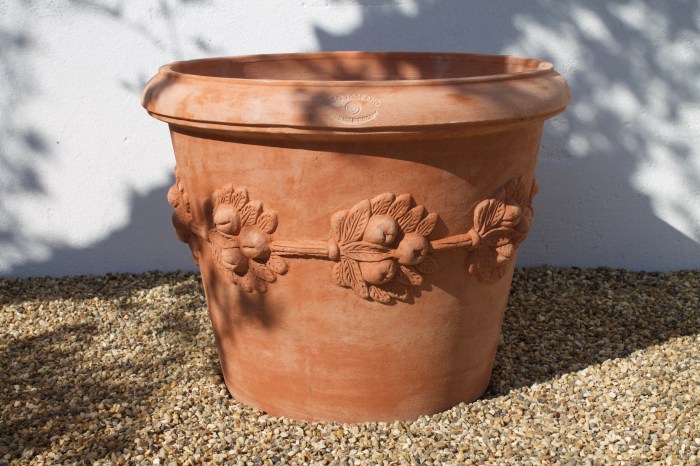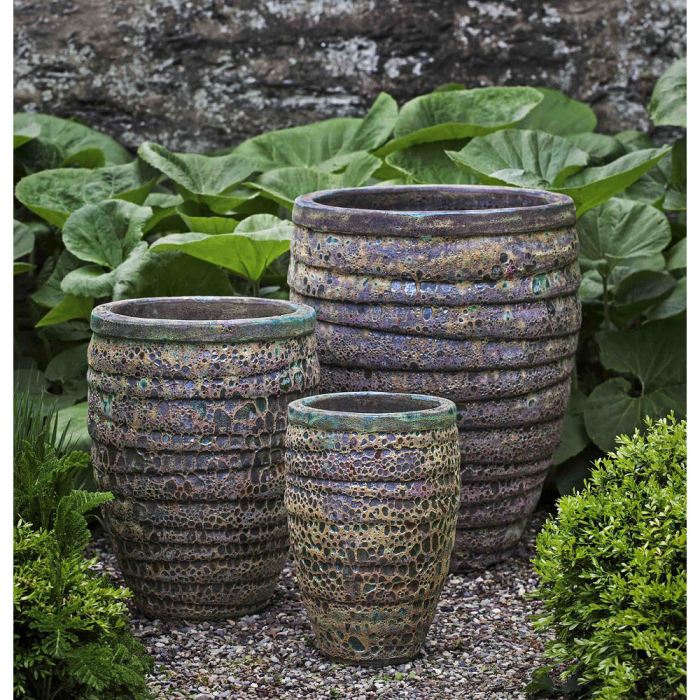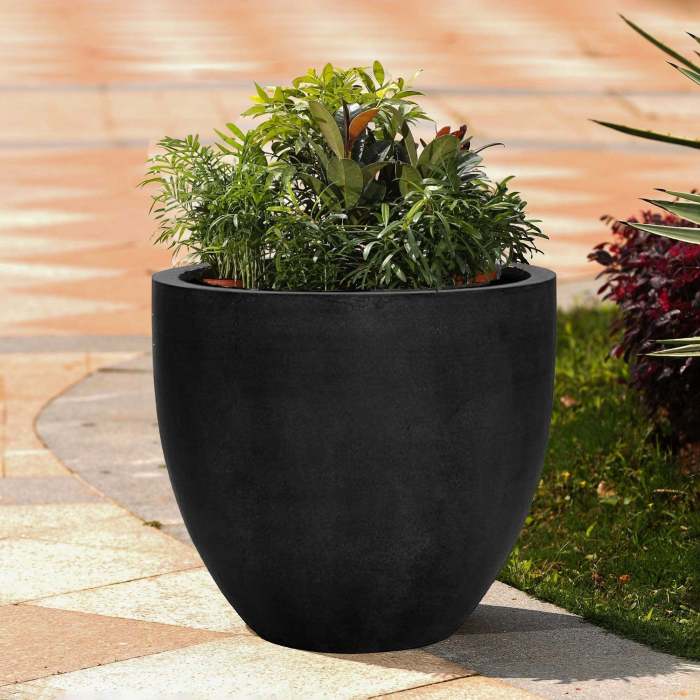Manufacturing Process

Italian terracotta plant pots – The creation of Italian terracotta pots is a process steeped in tradition, yet constantly evolving with modern innovations. From the sourcing of raw materials to the final firing, each stage contributes to the unique character and quality of these iconic vessels. Understanding this process reveals the artistry and craftsmanship behind these seemingly simple objects.The process begins with the selection of high-quality clay, often sourced locally in regions known for their rich clay deposits.
This clay, typically a reddish-brown hue due to its iron oxide content, is then carefully prepared. This preparation involves removing impurities, adding water to achieve the desired consistency, and often incorporating other materials to enhance the clay’s properties, such as sand or grog (previously fired clay). This meticulous preparation directly impacts the final product’s strength, texture, and porosity.
Traditional and Modern Manufacturing Techniques
Traditional methods rely heavily on manual skill and time-honored techniques. Potters use a potter’s wheel, a centuries-old tool, to shape the clay into the desired form. This process requires significant skill and experience to create perfectly symmetrical and balanced pots. Decoration is often applied by hand, using simple tools and techniques, resulting in unique, handcrafted pieces. Firing is typically done in wood-fired kilns, a method that imparts a distinctive character to the finished product.
This traditional approach prioritizes craftsmanship and individuality, resulting in variations between pots.Modern techniques incorporate technology to increase efficiency and production volume. While some potters still utilize the potter’s wheel, many factories employ automated processes, including robotic shaping and molding. This allows for greater consistency in size and shape. Modern kilns, often gas-fired or electric, offer greater control over the firing process, leading to more predictable results.
Known for their rustic charm and durability, Italian terracotta plant pots are a popular choice for gardeners of all levels. However, for larger landscaping projects requiring substantial containers, the scale shifts dramatically. For those needing truly immense planters, options like those found at giant plant pots for trees provide a different solution. While not traditionally terracotta, these larger alternatives offer a similar aesthetic appeal for showcasing mature trees and shrubs, expanding the possibilities beyond the scope of standard Italian terracotta pots.
While modern methods prioritize efficiency, some manufacturers strive to maintain traditional aesthetic qualities through careful design and material selection.
Terracotta Pot Creation: A Step-by-Step Process
The creation of a terracotta pot involves several key steps. The following table Artikels these stages, detailing the materials and approximate time required for each:
| Step | Description | Materials | Time Required |
|---|---|---|---|
| Clay Preparation | Mixing clay with water, removing impurities, and adding temper if needed. | Clay, water, temper (sand, grog) | 1-2 hours |
| Shaping | Forming the clay into the desired pot shape using a potter’s wheel or mold. | Clay, potter’s wheel or mold | 30 minutes – 2 hours |
| Drying | Allowing the shaped pot to dry slowly to prevent cracking. | Pot | 1-3 days |
| Finishing | Smoothing the surface, applying any decorations or glazing. | Pot, smoothing tools, glaze (optional) | 30 minutes – 1 hour |
| Firing | Heating the pot in a kiln to high temperatures to harden it. | Pot, kiln, fuel (wood, gas, electricity) | 8-12 hours |
Impact of Firing Techniques, Italian terracotta plant pots
Different firing techniques significantly influence the final product’s appearance and durability. Wood-fired kilns produce pots with a unique, smoky character and often subtle variations in color and texture. The uneven heat distribution in wood-fired kilns can lead to interesting surface effects, adding to the rustic charm. However, these variations can also impact consistency. Gas-fired and electric kilns offer more precise temperature control, resulting in a more uniform finish and increased durability.
These kilns produce pots with a smoother, more consistent surface, although they might lack the unique character of wood-fired pieces. The choice of firing technique is a critical factor influencing both the aesthetic and functional qualities of the final terracotta pot. For instance, a lower firing temperature might result in a more porous pot, suitable for smaller plants, while a higher temperature produces a denser, more durable pot ideal for larger plants or outdoor use.
Types and Styles of Italian Terracotta Pots: Italian Terracotta Plant Pots

Italian terracotta pots, renowned for their rustic charm and enduring quality, exhibit a wide array of styles reflecting centuries of tradition and evolving design sensibilities. These variations stem from diverse regional influences, functional needs, and artistic expressions, resulting in a rich tapestry of shapes, sizes, and decorative techniques. Understanding these variations allows for a deeper appreciation of the craftsmanship and artistry inherent in these pieces.
Classification of Italian Terracotta Pots
The diversity of Italian terracotta pots can be categorized based on several key factors: size, shape, and decoration. Size ranges from miniature pots suitable for succulents to large, imposing vessels for substantial plants or decorative purposes. Shapes vary widely, from simple cylindrical forms to elaborate, sculpted designs. Decorative techniques range from understated elegance to vibrant, highly detailed ornamentation. This categorization allows for a more nuanced understanding of the diverse styles available.
Sizes and Shapes of Italian Terracotta Pots
The following bulleted list provides a glimpse into the variety of sizes and shapes commonly found in Italian terracotta pots. These dimensions are approximate and can vary considerably depending on the artisan and intended use.
- Small Pots (under 6 inches diameter): Ideal for seedlings, herbs, or small succulents. Often feature simple, cylindrical or spherical shapes.
- Medium Pots (6-12 inches diameter): Suitable for a wide range of plants, from flowering annuals to small shrubs. Shapes can be more varied, including conical, urn-shaped, and fluted designs.
- Large Pots (over 12 inches diameter): Used for larger plants, trees, or as standalone decorative elements. Often feature more elaborate designs and thicker walls.
- Cylindrical Pots: A classic, versatile shape suitable for various plants and sizes.
- Conical Pots: Tapering towards the base, these pots offer a visually appealing, slightly modern twist.
- Urn-Shaped Pots: Characterized by a bulbous body and a narrow neck, these pots evoke a sense of classical elegance.
- Fluted Pots: Featuring vertical grooves or fluting, these pots add texture and visual interest.
Decorative Techniques and Styles of Italian Terracotta Pots
The decorative techniques employed on Italian terracotta pots enhance their aesthetic appeal and reflect regional styles and artistic traditions.
| Style Name | Description of Style | Image Description |
|---|---|---|
| Rustic Tuscan | Simple, unadorned shape with a naturally rough, earthy texture. Color is typically a warm, reddish-brown with variations in tone. May show slight imperfections, adding to its charm. | A deep reddish-brown pot, slightly irregular in shape, with a matte finish. The texture is visibly rough, with small pits and variations in color. The overall impression is one of natural, unrefined beauty. |
| Ornate Sicilian | Elaborate designs, often featuring hand-painted floral motifs, geometric patterns, or scenes of everyday life. Colors are typically brighter, including yellows, greens, and blues, in addition to the base terracotta. The texture may be smoother than rustic styles. | A large, urn-shaped pot with a smooth, almost polished surface. Intricate floral designs in shades of yellow, green, and blue are painted on the surface, showcasing detailed brushwork. The overall effect is vibrant and ornate. |
| Glazed Umbrian | Characterized by a glossy, protective glaze applied over the terracotta. The glaze can be clear, enhancing the natural color of the terracotta, or colored, adding a layer of vibrant hue. The texture is smooth and polished. | A cylindrical pot with a smooth, glossy surface. A clear glaze enhances the rich reddish-brown color of the terracotta, creating a subtle sheen. The surface is uniform and reflects light evenly. |
| Antique Florentine | Aged appearance, often with a faded color and signs of wear. May have subtle cracks or imperfections that add to its character. Shapes are usually classic and simple. | A medium-sized, cylindrical pot with a faded, almost ochre color. The surface shows signs of wear, with subtle cracks and a slightly uneven texture. The overall impression is one of aged elegance and history. |
Detailed FAQs
Are Italian terracotta pots frost-proof?
No, they are porous and susceptible to cracking in freezing temperatures. Winter protection is essential.
How do I prevent salt buildup on my terracotta pots?
Regular rinsing with clean water and avoiding over-watering can minimize salt buildup.
Can I paint Italian terracotta pots?
Yes, but use a porous paint designed for terracotta to allow for breathability.
How long do Italian terracotta pots typically last?
With proper care, high-quality terracotta pots can last for many years, even decades.






0